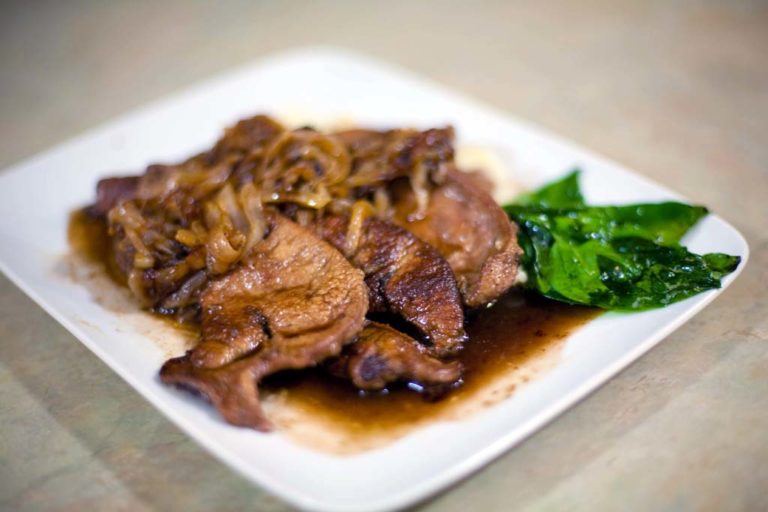
Chef's notes:
The first time I cooked liver and onions, I was about 20 years old and cooking food for 250 kids at a German language immersion village. I had no idea what I was doing, but somehow the dish turned out okay. Not that the kids noticed. Fast forward almost 10 years, and when I look at a few slices of calf’s liver, I know exactly what to do: fry them quickly in butter, and serve with sweet and sour onions. The onions are sweet because they’ve been caramelized and sour because they were deglazed with vinegar. It is really quite tasty and easy to make.
Ingredients
- 1 pound calf's liver
- 2 medium white onions
- 4 Tbsp vegetable oil
- 4 Tbsp butter
- Sea salt
- Black pepper
- Flour
- Vinegar
- Demi-glace (optional)
Pan-Fried Calf's Liver and Caramelized Onions Recipe Served with a Sweet and Sour Demi-Glace Pan-Sauce
- Assemble the ingredients for the recipe. If you are unable to find fresh calf’s liver, you should be able to find it frozen. It will often come pre-sliced, which can be to your advantage since slicing liver can be a bit difficult. The demi-glace is optional since there is a pretty good chance you won’t have any on hand. The sauce will still be good without it.
- Chop and fry the onions. Peel the onions and cut them in half from top to bottom. Slice them by cutting into strips, also from top to bottom. Onion strips cut in this manner are much more attractive looking than half-moons. Alternatively, the onions could be cut into rings.
- Caramelize the onions. Melt 1 tablespoon oil and 1 tablespoon butter in a frying pan over medium heat. Add the onions and 1 teaspoon of salt. Sweat the onions over medium heat until transparent and wet. Keep cooking them until they begin to turn brown, like the ones in the pan to the right. Then, deglaze the pan with ½ cup of vinegar. Set the pan to the side and start with the calf’s liver.
- Slice the calf's liver thinly. If you have found fresh calf’s liver, have your butcher clean it and remove the veins. If possible, have them slice it for you at ½-inch thickness, otherwise you will have to slice it yourself, which is tricky. That is, unless you freeze the liver slightly first, which makes the liver firm enough to hold its shape while you slice it.
- Salt and pepper the calf's liver. Now that the calf’s liver is sliced nicely, it must be seasoned. I recommend that you refrain from seasoning it with anything other than sea salt and fresh-cracked black pepper. If you need more flavor, try adding a little mace or crumbled sage.
- Dredge the calf's liver in flour. The seasoning on the calf’s liver slices should have made them a little moist, which will help the flour to stick to them. You will want to use cake or all-purpose flour for this. Bread flour will work, but the consistency is not as nice because if its high-gluten content.
- Cook the calf's liver quickly. Melt 3 tablespoons of butter with 3 tablespoons of oil over medium-high heat in a large skillet. Once up to heat, lay the dredged calf’s liver slices in the pan and fry them briefly—no more than 1 minute each side—unless you like chewy liver. Set the cooked liver to the side and toss the onions back in the pan. Add a splash of wine, stock, or the demi-glace, scrape up the good stuff (fond) stuck to the bottom of the pan, and put on top of the liver. Commence eating.
Tips & Tricks
- Try to buy calf’s liver that has already been cleaned and sliced.
- If you have to slice your own calf’s liver, put it in the freezer for a while until it starts to stiffen up, making it easier to slice.
- I recommend using calf or veal liver because it is milder tasting than beef liver. If you are going to use beef liver, you may want more seasoning. Some people say that soaking it in milk helps to reduce its strong flavor.
- I like to use white onions for this recipe because they have a lot of onion flavor, which you may want when dealing with liver.
- Caramelizing onions takes time. Don’t think you can just crank the heat to high and do it in half the time.
- Don’t cook the calf’s liver past rare or medium-rare. After that, it gets really chewy and the flavors get stronger.
- Eat the calf’s liver soon after cooking.
